Fig. 5.

The Plasmodium falciparum UpsA promoter (from the PFD1235w var gene) is associated with epigenetic changes in the surrounding locus and affects the expression of surrounding elements. (A) Growth curves of lines cultured in the presence of the selection agents WR99210 and BSD (open symbols) or WR99210 alone (closed symbols). Parasite cultures were seeded into replicate wells at 1% parasitemia, all with 2.5 nM WR99210 but half with 2 μg/mL BSD. HLH transgenes containing the hrp3 promoter were not affected by the application of BSD pressure, while the growth of UpsA promoter-containing lines was delayed. Prior to application of drug, normal parasite growth was verified by attainment of parasitemia above 5% in complete medium. (B, C) In vitro SYBR Green I incorporation assays were performed against BSD (B) or WR99210 (C) using the ALH parasite lines selected in the presence of WR99210 and BSD (ALH-WB) or WR99210 alone (ALH-W). As a control, we included the HLH parasite line cultured in medium containing both WR99210 and BSD. IC50 values (shown as mean ± S.E.M., calculated from six independent experiments) were derived by regression analysis. (D-E) Luciferase activities of BSD pressured versus non-pressured cell populations, measured in relative luciferase units per million parasites. (D) Time-course of the luciferase activities of BSD sensitive and resistant populations of ALH parasites. As a control, we included the ALA1 parasite line that was cultured in the presence of WR99210 and BSD. (E) Luciferase activity of HLH cultures grown in the presence (HLH1-WB) or absence (ALA1-W) of BSD, harvested during late ring stages.
